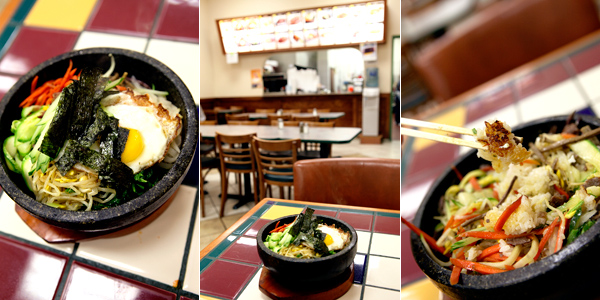
In terms of super foods, the Korean condiment kimchi belongs in the nutritional league of justice: full of lactobacilli, antioxidants, fiber, and vitamins, it is credited with aiding digestion, fighting cancer, and curing yeast infections. Not only that, but the Korean Agro-Fisheries Trade Corporation attributes the fermented vegetables with “restraining aging skin” and helping Nicolas Cage balance his mind and soul.
But whatever about all that, kimchi is just tasty. For the home cook, it adds a tangy, pungent heat to everything from scrambled eggs to stews and sandwiches — we are currently obsessed with the onion-brat-kimchi combo at Sun Street Breads — and, of course, it fits right into the mess of vegetables and egg atop a bibimbap (see Dong Yang’s version, below). As a side dish, kimchi can be a deliciously cool and crunchy salad.

It’s easy enough to find recipes for kimchi (here’s ours), but it’s a time-consuming project. What’s more, kimchi also has a slightly fizzy mouth feel and bubbles when you open it; this is normal, but it can unnerve the canning-wary. Happily, if you don’t have the time or fortitude to make kimchi, you can buy it at the store. Today we have reviewed two locally made brands with very different flavor profiles for your gustatory and gastrointestinal pleasure.
Angelica’s Garden Kim Chi
Angelica’s Garden Kim Chi ($12 / 16 oz.) combines organic green and Napa cabbages with a variety of vegetables and spices to create a kimchi that is surprisingly hot and dominated by flavors of spicy-sweet ginger and garlic. It is shredded in parts and has a softer, more succulent texture than some kimchi. In fact, it tasted a bit like a doctored-up sauerkraut.

The difference between sauerkraut and kimchi, aside from the obvious, is in the cabbage and how it is fermented. Sauerkraut uses white cabbage, shredded and dry cured in salt and spices, and then fermented in its own juices. Kimchi uses Napa cabbage, whole or chopped, wilted in salt water, rinsed and then fermented in a combination of spices and fish paste.
The flavor and juiciness of Angelica’s kimchi makes us wonder if it is, at the very least, made with some sauerkraut. Is that wrong? No, it’s delicious and she certainly doesn’t claim to have a traditional kimchi. Besides, some resources say that there are nearly 200 varieties of kimchi — who’s to say the flavor it produces isn’t traditional? In terms of use, however, we would say that Angelica’s Garden Kim Chi is a bit too saucy and hot to eat like a salad. We enjoyed it piled on top of flank steak, pork sausages, and salmon and it turns mild-mannered chicken soup into a nose-clearing, cold-killing dynamo.
Yon’s Foods Kimchi
In Yon’s Foods Kimchi ($5.39 / 16 oz.) all the traditional flavors — spicy chili pepper, bitter greens, subtly sweet cabbage, and an overall salty pungency from anchovy paste — form a cohesive, savory whole. The greens are soft, but the radish and cabbage are fresh, tender, and crunchy. And yes, there is that telltale fizz we have come to love and expect.
Although Yon’s Foods Kimchi is quite spicy and piquant, in comparison with Angelica’s it seems mild. Of the two, it would make an easier companion in a dish with ingredients that might otherwise be overwhelmed by the latter’s juicy ginger wallop. We like it scrambled with our eggs, melted in our quesadillas, and as a crunchy component in duck fried rice. It’s also brilliant eaten plain: We have more than once devoured half a jar standing at the counter.
Both Angelica’s Garden Kim Chi and Yon’s Foods Kimchi are widely available at local supermarkets; we happened to find them at Seward Co-op. You’ll find a list of store locations for Angelica’s Garden products here.


“gustatory and gastrointestinal” – nice turn of phrase
How surprising to read this, having stood in my own Minneapolis kitchen today devouring Yon’s from the jar. I thought it was just me.
There’s a pretty kickass mild kimchi down at Mill City Farmer’s Market from Kiss My Cabbage. She sells out fast, so plan to get there early!
And…. Just finished my jar of Yon’s Kimchi last night. Time to grab a new one.
Thanks for sharing, I’ve been wanting to buy some Kimchi for a Korean meal – but honestly I had no idea what was good locally – awesome to see a review!
-Jade
I also think that Kiss My Cabbage’s Kimchi and sauerkraut are far more superior in flavor! Do try them out if you love kimchi.
Angelica’s Kim Chi is my favorite, hands down. She’s been perfecting her craft for a long time and grows a lot of her own produce.
This seems to be an article discussing flavor only. When it comes to ingredients, Angelica sources from her own farm as well as other farms in the area, using only organic and sustainably grown produce, with deep awareness of soil building practices woven into her philosophy. I don’t know if Yon’s is organic or how she sources her veggies and that is an important factor to me. Yon’s certainly has a rich and delicious flavor with the addition of the fish sauce. This adds sugar, by the way, unless she is using homemade fish sauce or Red Boat brand fish sauce. Kiss My Cabbage has her own unique flavorprint that is extremely delicious but fairly mild in terms of punch, and although she makes it on her farm, I don’t think she is using all farm produce. I say, sourcing produce is very important, and also- to each their own bacterias, and subsequent tastes! More fermenters! More picklers! A call to action!